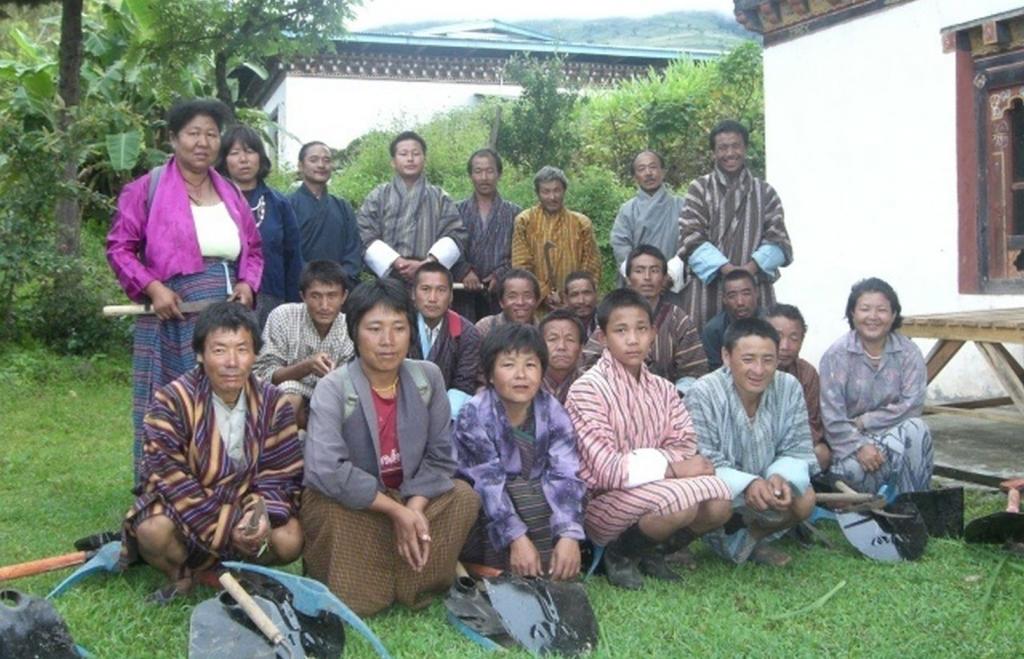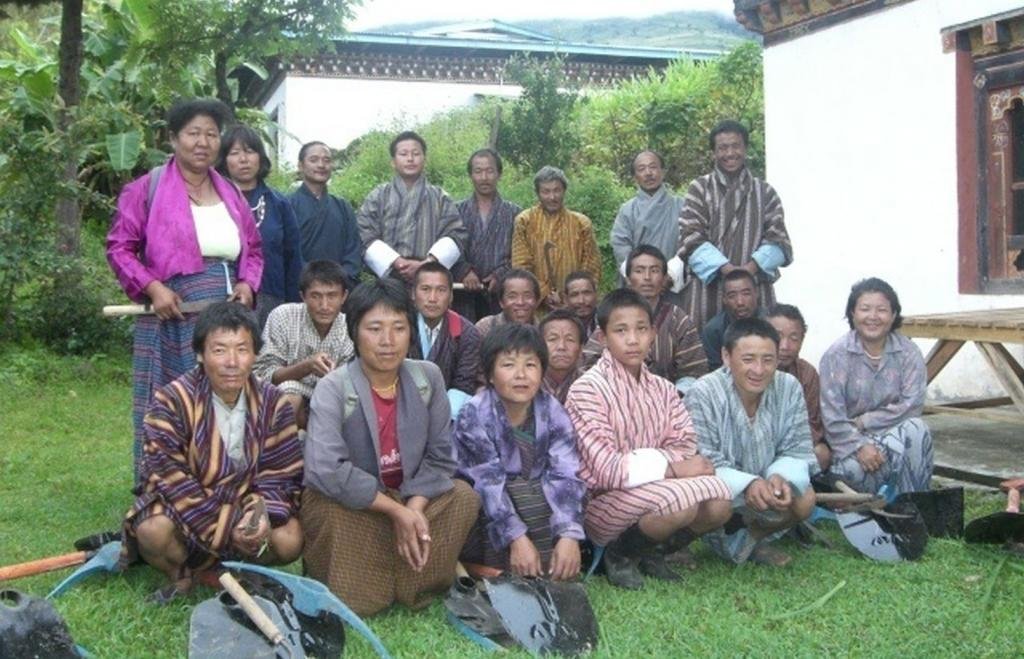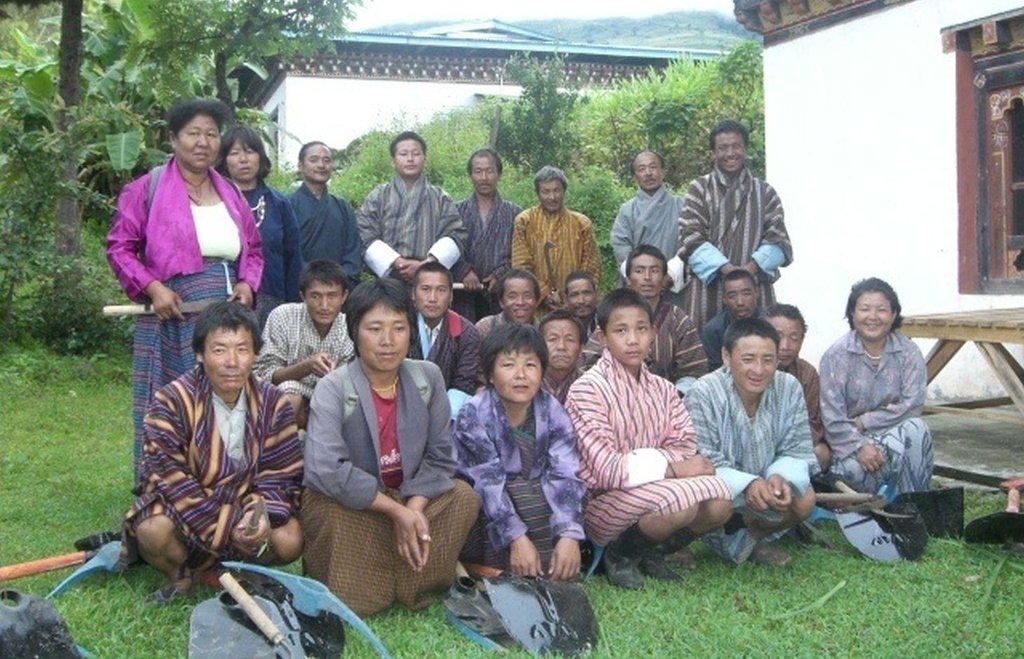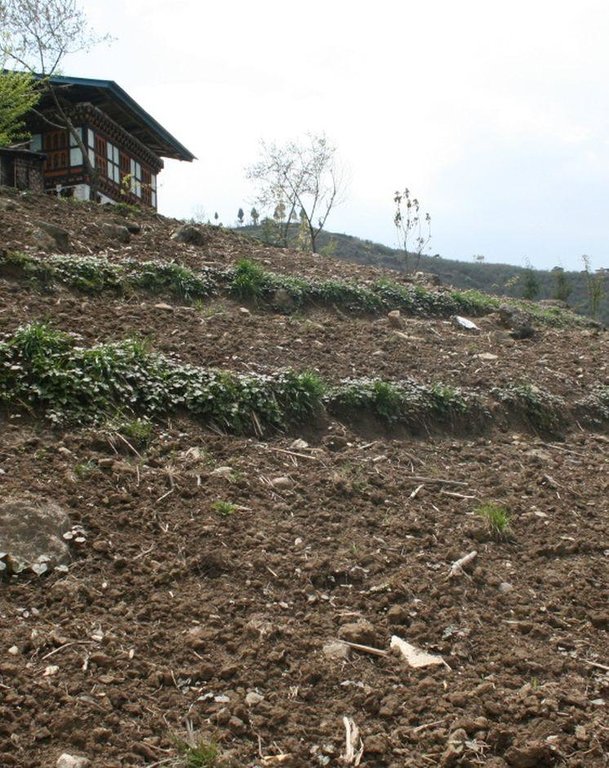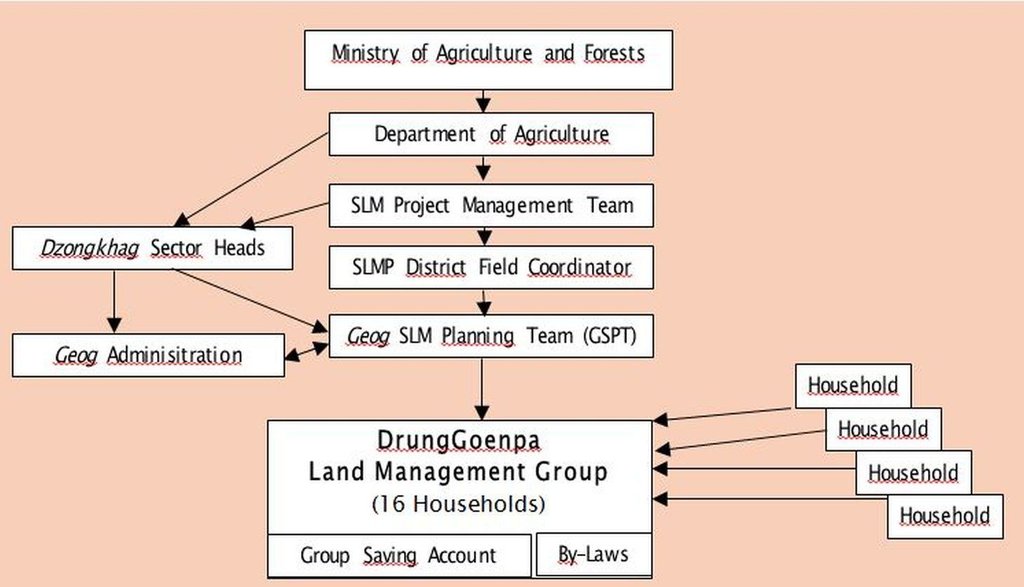Land Management Group [ภูฏาน]
- ผู้สร้างสรรค์:
- การอัพเดท:
- ผู้รวบรวม: Karma Dorji
- ผู้เรียบเรียง: –
- ผู้ตรวจสอบ: Fabian Ottiger
Phazhing Zinchung Tshogpha (Dzobgkha)
approaches_2493 - ภูฏาน
ดูส่วนย่อย
ขยายทั้งหมด ย่อทั้งหมด1. ข้อมูลทั่วไป
1.2 รายละเอียดที่ติดต่อได้ของผู้รวบรวมและองค์กรที่เกี่ยวข้องในการประเมินและการจัดเตรียมทำเอกสารของแนวทาง
ชื่อของโครงการซึ่งอำนวยความสะดวกในการทำเอกสารหรือการประเมินแนวทาง (ถ้าเกี่ยวข้อง)
MoA (MoA) - ภูฏานชื่อของโครงการซึ่งอำนวยความสะดวกในการทำเอกสารหรือการประเมินแนวทาง (ถ้าเกี่ยวข้อง)
National Soil Services Centre (National Soil Services Centre) - ภูฏาน1.3 เงื่อนไขที่เกี่ยวข้องกับการใช้ข้อมูลที่ได้บันทึกไว้ผ่านทาง WOCAT
วันที่เก็บรวบรวมข้อมูล (ภาคสนาม):
25/03/2011
ผู้รวบรวมและวิทยากรหลักยอมรับเงื่อนไขเกี่ยวกับการใช้ข้อมูลที่ถูกบันทึกผ่านทาง WOCAT:
ใช่
2. คำอธิบายของแนวทาง SLM
2.1 การอธิบายแบบสั้น ๆ ของแนวทาง
Land Management Group uniting all households in a community to plan and implement SLM and cash-generating activities
2.2 การอธิบายอย่างละเอียดของแนวทาง
การอธิบายอย่างละเอียดของแนวทาง:
Aims / objectives: A Land Management Group (LMG) unites all households of a village and aims to advocate, plan and implement SLM activities, based on the land-based issues of that particular community. The LMG has formal by-laws, drafted interactively with the community, and has its own group saving account, as access to credit and proper savings is still a real constraint in remote areas. A first LMG was started in 2008 in Drunggoenpa chiog in Radhi geog, Trashigang Dzongkhag, East-Bhutan. The idea for the LMG was based on pioneering work of the Renewable Natural Resource Research Centre Bajo, Wangdue Dzongkhag, in Salamji chiog, Dagana Dzongkhag.
Methods: In an effort to reinforce the social cohesion of communities and to improve the efficiency of planning for implementing SLM interventions, SLMP has initiated Land Management Groups. A LMG is considered very useful to overcome one of the main constraints of SLM implementation in Bhutan: labour-shortage. Many individual households have a growing lack of labour and therefore difficulties to implement labour-intensive SLM activities such as terracing, stone bunding or afforestation work.
Stages of implementation: LMGs are especially suitable for smaller communities, where households live relatively close to each other and have a good community bond. Instead of inter-acting with many individual households separately, the extension staff can also target their services, such as training programmes and technical guidance, to the group. The Drunggoenpa LMG was supported in their group formation process with regular meetings and took part in the annual participatory SLM action plan-ning for the chiog, identifying key land-based problems, their causes and possi-ble SLM interventions. Implementation of these SLM activities, such as grass strip establishment, stone check dam construction, group private forest establishment, vegetable production and tree and bamboo plantation, was carried out in a labour-sharing approach. Pooling labour in the group, all the land of the group members is converted or treated.
Role of stakeholders: This enables vulnerable families including single-headed households and the poorest-of-poor, to participate and get access to more labour-intensive SLM interventions. Apart from the pure SLM interventions, attention is given to cash-generating activities such as vegetable production and potato cultivation, to enhance the livelihoods of the farmers.
Other important information: Costs of forming a LMG including implementation of a series of SLM activities at the village level are limited(less than US$2,000 annually).
2.3 รูปภาพของแนวทาง
2.5 ประเทศ ภูมิภาค หรือสถานที่ตั้งที่ได้นำแนวทางไปใช้
ประเทศ:
ภูฏาน
ข้อมูลเฉพาะเพิ่มเติมของสถานที่ตั้ง:
Trashigang Dzongkhag, Radhi geog, Drung Goempa Chiog
2.6 วันที่เริ่มต้นและสิ้นสุดของแนวทาง
ระบุปีที่เริ่ม:
2008
การสิ้นสุดลง (ถ้าแนวทางไม่ได้ใช้อีกต่อไป):
2012
2.7 ประเภทของแนวทาง
- ใช้โครงงานหรือแผนงานเป็นฐาน
2.8 เป้าหมายหรือวัตถุประสงค์หลักของแนวทาง
The Approach focused mainly on SLM with other activities (vegetable production, potato production for cash income generation)
- To overcome labour constraints of labour-intensive SLM activities by working in a group, becoming more time-efficient
- To enhance the community bond and give access to all households to SLM activities
The SLM Approach addressed the following problems: - Severe land degradation in the village through landslides and surface erosion on very steep dryland
- Overgrazing by cattle, causing crop damage and forest degradation
- Lack of timber as result of forest degradation and deforestation
2.9 เงื่อนไขที่เอื้ออำนวยหรือเป็นอุปสรรคต่อการนำเทคโนโลยีภายใต้แนวทางนี้ไปปฏิบัติใช้
บรรทัดฐานและค่านิยมทางสังคม วัฒนธรรม ศาสนา
- เป็นอุปสรรค
Labour-intensive SLM activities are potentially excluding vulnerable households from access to SLM support
Treatment through the SLM Approach: Group approach enables the inclusion of all households, making use of labour-sharing
กรอบแนวทางในการดำเนินการด้านกฎหมาย (การถือครองที่ดิน สิทธิในการใช้ที่ดินและน้ำ)
- เอื้ออำนวย
The existing land ownership, land use rights / water rights greatly helped the approach implementation: All group members own land and this is a great help to implement SLM activities as there is a great sense of ownership.
ปริมาณงานที่ทำได้ กำลังคนที่มีให้
- เป็นอุปสรรค
Labour-intensive character of some of the SLM interventions
Treatment through the SLM Approach: Labour-sharing approach in group eases constraint, even for vulnerable and single-headed households
3. การมีส่วนร่วมและบทบาทของผู้มีส่วนได้ส่วนเสียที่เกี่ยวข้อง
3.1 ผู้มีส่วนได้ส่วนเสียที่เกี่ยวข้องในแนวทางนี้และบทบาท
- ผู้ใช้ที่ดินระดับท้องถิ่นหรือชุมชนระดับท้องถิ่น
group with local by-laws
No gender bias; women are equally participating in more physically demanding activities, such as ploughing. Yes, little. All community households are participating in the land management group, including some female headed and poorest households.
- ผู้เชี่ยวชาญ SLM หรือที่ปรึกษาการเกษตร
- รัฐบาลระดับท้องถิ่น
Local government (geog and chiog level)
- รัฐบาลแห่งชาติ (ผู้วางแผน ผู้ทำการตัดสินใจ)
ถ้ามีผู้มีส่วนได้ส่วนเสียหลายคนที่เกี่ยวข้องให้ระบุหน่วยงานตัวแทน:
Initial idea was developed after field visit by community members and Geog SLM Planning Team (GSPT) to Selamji Land Management group in Dagana Dzongkhag.
3.2 การเกี่ยวข้องของผู้ใช้ที่ดินระดับท้องถิ่นหรือชุมชนระดับท้องถิ่นในช่วงต่างๆของแนวทาง
| ความเกี่ยวข้องของผู้ใช้ที่ดินระดับท้องถิ่นหรือชุมชนระดับท้องถิ่น | ระบุผู้ที่มีส่วนเกี่ยวข้องและอธิบายกิจกรรม | |
|---|---|---|
| การริเริ่มหรือการจูงใจ | ปฏิสัมพันธ์ | Community members were inspired by visit to Salamji, a SLM focal village in Dagana Dzongkhag and advocated a similar approach in their village |
| การวางแผน | ปฏิสัมพันธ์ | Participatory SLM action planning, annually, to discuss land based issues, causes and potential SLM interventions |
| การดำเนินการ | ปฏิสัมพันธ์ | Range of SLM interventions such as grass strip establishment, stone check dam construction, group private forest plantation etc. technical guidance by local extension staff |
| การติดตามตรวจสอบหรือการประเมินผล | ปฏิสัมพันธ์ | Participatory Monitoring & Evaluation meetings with geog extension staff and members of the municipality administration; includes regular insight in group saving account balance and status for transparency |
| Research | ไม่มี |
3.3 แผนผังแสดงขั้นตอนการทำงาน (ถ้ามี)
คำอธิบาย:
Organisation chart of the Land Management Group
ผู้เขียน:
Hans van Noord (Schoutenkamp 43 Heteren The Netherlands)
3.4 การตัดสินใจเลือกใช้เทคโนโลยี SLM
ระบุผู้ที่ทำการตัดสินใจเลือกเทคโนโลยีมากกว่าหนึ่งวิธีไปปฏิบัติใช้:
- ผู้ใช้ที่ดินเป็นผู้ตัดสินใจหลัก โดยการสนับสนุนจากผู้เชี่ยวชาญ SLM
การอธิบาย:
.Annual Participatory SLM Action Planning to discuss land-based issue, causes and interventions options and priorities.
Decisions on the method of implementing the SLM Technology were made by mainly by SLM specialists with consultation of land users. Mainly by SLM specialists with consultation of land users; consultation process in context of participatory SLM action planning and participatory monitoring and evaluation meetings.
4. การสนับสนุนด้านเทคนิค การสร้างขีดความสามารถ และการจัดการด้านความรู้
4.1 การสร้างขีดความสามารถ / การอบรม
ได้มีการจัดอบรมให้แก่ผู้ใช้ที่ดินหรือผู้มีส่วนได้ส่วนเสียคนอื่น ๆ หรือไม่:
ใช่
ให้ระบุว่าใครเป็นผู้ได้รับการอบรม:
- ผู้ใช้ที่ดิน
รูปแบบการอบรม:
- กำลังดำเนินการ
- เกษตรกรกับเกษตรกร
- จัดการประชุมสู่สาธารณชน
หัวข้อที่พูด:
Training to community members on group formation and specific technical SLM interventions such as organic vegetable production, grass strip establishment, group private forestry, stone check dam construction, bamboo plantation etc. The annual participatory SLM action planning and natural resource mapping also contributed considerably in raising awareness of all villagers, developing their understanding of causal chain relations of their key land problems.
4.2 การบริการให้คำแนะนำ
ผู้ใช้ที่ดินมีการเข้าถึงการรับบริการให้คำปรึกษาหรือไม่:
ใช่
ระบุว่ามีบริการให้คำปรึกษาหรือไม่:
- ไปเยี่ยมชมสถานที่
การอธิบาย/แสดงความคิดเห็น:
Name of method used for advisory service: SLM advisory service by extension staff; Key elements: Grass strip establishment, Group formation, Organic vegatable Production; Renewable Natural Resource Extension staff of the geog are providing on-the-job advisory service to the group members through regular visits to the community to carry out trainings, which are mainly hands-on, with a demonstration site on the land of one of the group members. At the end of the training the group members plan for a rotation schedule to carry out the SLM activity on the land of all group members.
Advisory service is quite adequate to ensure the continuation of land conservation activities; Determination expressed by group to continue with activities post-project.
4.3 การเสริมความแข็งแกร่งให้กับสถาบัน (การพัฒนาองค์กร)
สถาบันได้รับการจัดตั้งขึ้นมาหรือเสริมความแข็งแกร่งโดยแนวทางนี้หรือไม่:
- ใช่ อย่างมาก
ระบุระดับของสถาบันที่ได้รับการเสริมความแข็งแกร่งหรือจัดตั้งขึ้นมา:
- ท้องถิ่น
ระบุประเภทของการให้ความช่วยเหลือสนับสนุน:
- การสร้างขีดความสามารถ / การอบรม
ให้รายละเอียดเพิ่มเติม :
Considerable support to the Land Management Group through group formation process guidance and concentrated effort to plan for and implement a range of SLM focused activities, combined with hands-on training events.
4.4 การติดตามตรวจสอบและประเมินผล
การติดตามตรวจสอบและประเมินผลเป็นส่วนหนึ่งของแนวทางหรือไม่:
ใช่
ความคิดเห็น:
bio-physical aspects were regular monitored by project staff, land users through observations; indicators: Regular observations by project staff together with group members of grass strips, riser height, check dam infill and tree seedling growth
technical aspects were regular monitored by project staff, land users through observations; indicators: Regular observations and measurements by project staff together with group members of grass strip area, number of check dams and plantation status (bamboo and tree seedlings)
socio-cultural aspects were regular monitored by project staff, land users through observations; indicators: Regular observations by project staff together with group members on group status and feedback of group on implementation progress and issues and future activities
economic / production aspects were regular monitored by project staff, land users through observations; indicators: Regular observations by project staff together with group on crop yield, fodder grass production along grass strips (# of loads) and animal production increase (milk in litres, butter and cheese in kilos)
area treated aspects were ad hoc monitored by project staff, land users through measurements; indicators: Regular measurement by project staff and group members of area treated with grass strips and area planted with bamboo and tree seedlings
no. of land users involved aspects were ad hoc monitored by project staff, land users through observations; indicators: Ad-hoc observation by group members (attendance register)
management of Approach aspects were regular monitored by project staff, land users through observations; indicators: Regular observations in participatory monitoring and evaluation meetings with group members
There were few changes in the Approach as a result of monitoring and evaluation: In the initial group formation process these was considerable involvement by the local extension staff, which has been reduced as the group members have taken upon themselves most of the planning and implementation as their confidence levels have risen and their technical capability enhanced by a series of training events.
There were few changes in the Technology as a result of monitoring and evaluation
5. การสนับสนุนด้านการเงินและวัสดุอุปกรณ์
5.1 ระบุงบประมาณประจำปีสำหรับแนวทาง SLM นี้
ถ้าหากว่างบประมาณประจำปีไม่เป็นที่ทราบแน่นอน ให้ระบุช่วงลงไป:
- < 2,000
แสดงความคิดเห็น (แหล่งของการระดมทุน ผู้บริจาคคนสำคัญ):
Approach costs were met by the following donors: international (GEF, World Bank): 85.0%; local community / land user(s) (Land Management Group): 15.0%
5.2 การสนับสนุนด้านการเงิน / วัสดุอุปกรณ์ให้แก่ผู้ใช้ที่ดิน
ผู้ใช้ที่ดินได้รับการสนับสนุนด้านการเงิน / วัสดุอุปกรณ์ไปปฏิบัติใช้เทคโนโลยีหรือไม่:
ใช่
5.3 เงินสนับสนุนสำหรับปัจจัยนำเข้า (รวมถึงแรงงาน)
- อุปกรณ์
| ระบุปัจจัยนำเข้าที่ได้รับการสนับสนุน | เห็นด้วยระดับไหน | ระบุเงินสนับสนุน |
|---|---|---|
| เครื่องมือ | ได้รับการช่วยเหลือทางการเงินบางส่วน | |
- การเกษตร
| ระบุปัจจัยนำเข้าที่ได้รับการสนับสนุน | เห็นด้วยระดับไหน | ระบุเงินสนับสนุน |
|---|---|---|
| เมล็ด | ได้รับการช่วยเหลือทางการเงินแบบเต็ม | |
| Seedlings | ได้รับการช่วยเหลือทางการเงินแบบเต็ม | |
ถ้าแรงงานโดยผู้ใช้ที่ดินเป็นปัจจัยนำเข้าที่มีอยู่มากมาย ระบุด้วยว่าเนื่องจาก:
- สมัครใจ
ความคิดเห็น:
Labour contribution to the land management group is in principle voluntary, but for some of the specific SLM interventions SLMP pays the households a fixed amount per area converted or treated with grass strips, planted with bamboo rhizomes etc. These cash payments are an incentive to establish and start certain techniques for which considerable labour is required. All recurrent activities are carried out by the group members.
Tool sets are provided to the group, consisting of hand tools as pickaxe, crowbar and spade. Additionally, seeds and seedlings needed for SLM activities are provided free of cost by SLMP, such as bamboo rhizomes, tree seedlings, fruit tree seedlings, fencing material for the group private forest establishment and temperate grass seed mixture.
5.4 เครดิต
มีการจัดหาเครดิตมาให้ภายใต้แนวทาง SLM หรือไม่:
ไม่ใช่
6. การวิเคราะห์ผลกระทบและการสรุป
6.1 ผลกระทบของแนวทาง
ช่วยให้ผู้ใช้ที่ดินนำเอาเทคโนโลยี SLMไปใช้และบำรุงรักษาสภาพไว้ได้หรือไม่:
- ไม่ใช่
- ใช่ เล็กน้อย
- ใช่ ปานกลาง
- ใช่ อย่างมาก
Soil and water conservation efforts have improved considerably with at least o.5 ha of land converted to/treated with SLM, such as grass strips, stone check dams and bamboo and tree plantation areas. A visible impact has been made as the area of grass strips and developing bench terraces are visible for the whole municipality.
ทำให้กลุ่มด้อยโอกาสมีอำนาจทางสังคมและเศรษฐกิจหรือไม่:
- ไม่ใช่
- ใช่ เล็กน้อย
- ใช่ ปานกลาง
- ใช่ อย่างมาก
The most vulnerable household are members of the group, representing the poorest families and female-headed households. Some of the hands-on trainings were carried out on the land of these households to give them first access and overcome their labour shortage constraint.
Did other land users / projects adopt the Approach?
- ไม่ใช่
- ใช่ เล็กน้อย
- ใช่ ปานกลาง
- ใช่ อย่างมาก
Approach has been rolled out to other communities in Trashigang Dzongkhag to scaling-up municipalities of SLMP, based on the experiences with the Drung Goenpa Land Management Group
Did the Approach lead to improved livelihoods / human well-being?
- ไม่ใช่
- ใช่ เล็กน้อย
- ใช่ ปานกลาง
- ใช่ อย่างมาก
Moderate improvement of livelihoods through improved vegetable production (now self-sufficiency and cash generating), stabilization of land degradation, better workability of cropland through grass strip and bench terrace development and improved animal production through improved fodder quality and availability. Also the workload has been reduced by collecting fodder through cut-and-carry near the farm from the grass strips, instead of having to walk far to the forest for fodder collection. The group approach is able to tackle the labour constraint faced previously and includes all vulnerable households.
Did the Approach help to alleviate poverty?
- ไม่ใช่
- ใช่ เล็กน้อย
- ใช่ ปานกลาง
- ใช่ อย่างมาก
Considerable improvement in food self-sufficiency / security by vegetable production and increased yield on cropland treated with grass strips. Also clear improvement of animal production because of fodder improvement with the grass strips providing readily available quality fodder. Potato has now become a cash crop and some households sell vegetables, whereas they had to purchase in the recent past.
6.2 แรงจูงใจหลักของผู้ใช้ที่ดินเพื่อที่จะนำ SLM ไปปฏิบัติใช้
- การผลิตที่เพิ่มขึ้น
- กำไร (ความสามารถ) อัตราส่วนค่าใช้จ่ายต่อผลประโยชน์ที่เพิ่มขึ้น
- ภาระงานลดลง
- การเข้าร่วมสมทบในขบวนการ โครงการ กลุ่ม เครือข่าย
- จิตสำนึกด้านสิ่งแวดล้อม
- well-being and livelihoods improvement
6.3 ความยั่งยืนของกิจกรรมของแนวทาง
ผู้ใช้ที่ดินสามารถทำให้สิ่งต่างๆ ที่ได้ปฏิบัติใช้โดยแนวทางนี้ยั่งยืนได้หรือไม่ (โดยไม่มีการสนับสนุนจากภายนอก):
- ไม่แน่ใจ
ถ้าตอบว่าไม่หรือไม่แน่ใจ ให้ระบุและแสดงความคิดเห็น :
The group is expected to be able to sustain their activities independently, but a group process is always complex and there are no certainties looking forward. The improved sense of community bonding and mutual trust however is clearly expressed and essential for future sustainability of the group, supported by the existing group saving account, facilitating financial sustainability.
6.4 จุดแข็งและข้อได้เปรียบของแนวทาง
| จุดแข็ง / ข้อได้เปรียบของแนวทางในทัศนคติของผู้ใช้ที่ดิน |
|---|
| Are equal.... |
| จุดแข็ง / ข้อได้เปรียบของแนวทางในทัศนคติของผู้รวบรวมหรือวิทยากรหลัก |
|---|
|
Enhanced community bond and mutual trust Labour-sharing approach in group eases the difficulty to implement labour-intensive SLM activities Vegetable production in group has improved food security and generates cash income Saving account of group facilitates credit need of households and serves as common bond between households (How to sustain/ enhance this strength: Continued support and guidance to group Continue labour-sharing in future activities Increase production area Regular bookkeeping and cash generating activities to add to savings) |
6.5 จุดอ่อน / ข้อเสียเปรียบของแนวทางและวิธีในการแก้ไข
| จุดอ่อน / ข้อเสียเปรียบในทัศนคติของผู้ใช้ที่ดิน | สามารถแก้ไขปัญหาได้อย่างไร |
|---|---|
| Are equal... |
| จุดอ่อน / ข้อเสียเปรียบในทัศนคติของผู้รวบรวมหรือวิทยากรหลัก | สามารถแก้ไขปัญหาได้อย่างไร |
|---|---|
|
Initially freely grazing cattle caused problems between group members with implementation of SLM activities Group expresses interest in having a simple meeting venue to facilitate group meetings |
By-laws help to overcome issues and working together in a group has improved mutual trust Seek support to construct simple meeting hall |
7. การอ้างอิงและการเชื่อมต่อ
7.1 วิธีการหรือแหล่งข้อมูล
- ไปเยี่ยมชมภาคสนาม การสำรวจพื้นที่ภาคสนาม
- การสัมภาษณ์กับผู้ใช้ที่ดิน
ลิงก์และโมดูล
ขยายทั้งหมด ย่อทั้งหมดลิงก์
ไม่มีลิงก์
โมดูล
ไม่มีโมดูล


